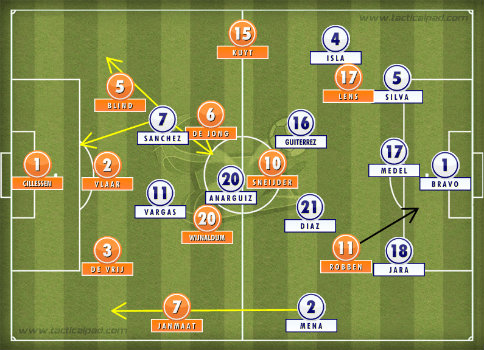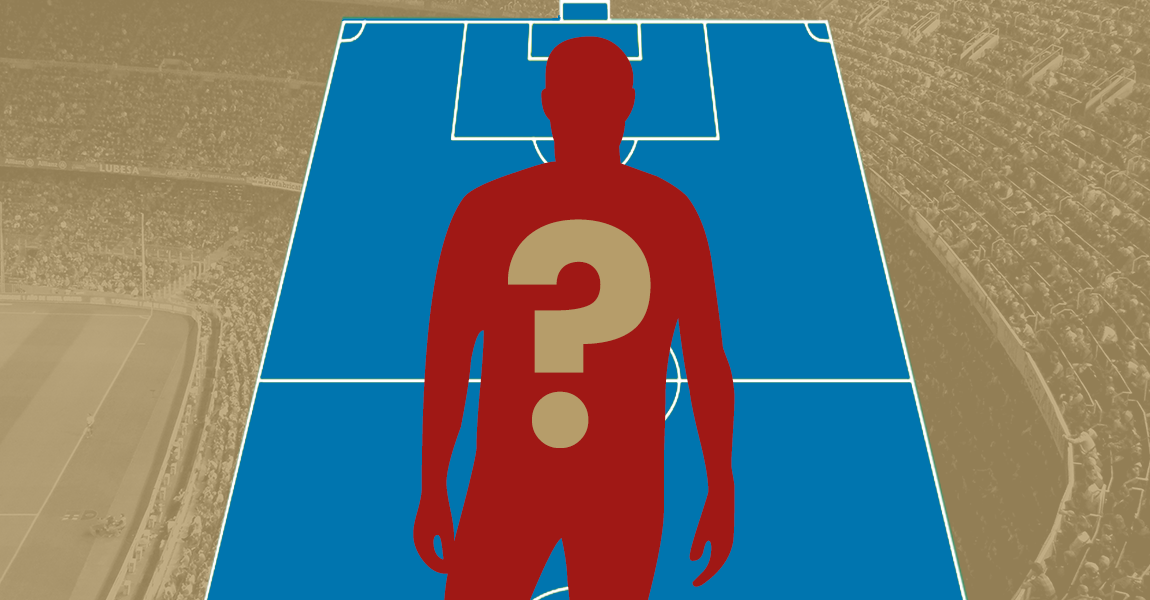With both teams already qualified for the knockout stages, this match would decide which team would finish top and which team would have to be content with second. While the winner would gain first place outright, a draw would be enough for the Dutch to qualify first on goal difference. Both teams knew the importance of first place, with the second placed team most likely facing the daunting possibility of a round of 16 match-up with hosts Brazil. Even though the Netherlands beat Brazil in the quarter-finals in 2010, Brazil at home are a different proposition. Chile, of course, are well acquainted with their South American counterparts; in their last two World Cups (1998 and 2010), Chile were knocked out in the Round of 16 by Brazil. Neither team wanted to lose, setting up a cagey, tactical battle.
Formations and Line Ups
Netherlands (3-5-2): Cillessen, De Vrij, Vlaar, Blind, Janmaat, Wijnaldum, De Jong, Kuyt (Kongolo 89’), Sneijder (Fer 75’), Robben, Lens (Depay 69’)
Chile (3-4-1-2): Bravo, Silva (Valdivia 70’), Medel, Jara, Isla, Diaz, Gutierrez (Beausejour 45’), Mena, Aranguiz, Sanchez, Vargas (Pinilla 81’)
Goals: Fer 77’, Depay 90+2’

Netherlands 2-0 Chile
Chile press high, force Dutch long balls
Throughout the World Cup, Chile’s physical, energetic, hard-running style has captivated audiences and gained plaudits. Employing a high press, the South Americans stifled the Dutch and prevented the Europeans from gaining any sort of passing rhythm in this crucial encounter. The Chileans dominated possession, but whenever they lost the ball, the midfielders and forwards worked tirelessly, applying intense pressure to win back possession. The Dutch struggled to hold on to the ball in the first half and even more worryingly struggled to put together a consistent sequence of passes, allowing Chile to easily regain possession. In the first half, Chile had 74% possession and completed 239 passes. The Dutch, on the other hand, only completed 60 of their 95 passes; Chilean center back Gary Medel completed 62 passes in the first half alone. (stats from fourfourtwo.com, maybe a passing map)

Dutch first half passing, the red signifying failed passes (via FourFourTwo)
The Chilean high press and the Dutch inability to string together passes forced the Oranje to take a long ball approach to the game. The Dutch center backs aimed to bypass the midfield and the Chilean press by hitting the ball long to the strikers. Netherlands attempted 20 long balls in the first half, with only 5 reaching a Dutch player.
Dutch counter attack
The Dutch were forced into a long ball approach; however, Louis van Gaal set them up exactly for such a purpose as Netherlands employed a predominantly counterattacking system. The Dutch were overwhelmed in midfield; as a result, the Oranje had to use their superior pace to carve out chances. Lens and Robben upfront provided speed and dynamic movement. The long ball approach may have been planned by the Netherlands beforehand as well, as the center backs constantly looked for Jermain Lens, who targeted Francisco Silva, the right sided center back. The Dynamo Kyiv attacker’s movement troubled Silva, who had to resort to fouling Lens, giving away dangerous set-pieces considering the size disparity between the two teams.
RELATED ARTICLES
If the Dutch won the ball in midfield, they would look to spring Robben as quickly as possible, hoping to use the dribbling skills of the Bayern Munich man. Robben led the team with 4 successful dribbles and got the assist for Depay’s goal after a late counterattack. While the Dutch’s transition play may not have been as “artistic” or efficient as the French or the Colombians, Robben’s brilliance made the difference.
Netherlands man marking, Chile midfield runners expose it
Louis van Gaal set up his team to man-mark key Chilean players. Blind tracked Alexis Sanchez and Sneijder hounded Diaz for the majority of the game, and the rest of the Dutch midfield tracked Aranguiz as the Oranje tried to reduce influence of those Chileans on the game. The system resulted in a hard tackling style by the Dutch; they made 26 successful challenges in the game, the majority of them in midfield.

Netherlands’ tackles, illustration via FourFourTwo
The Dutch were committed to man-marking, with Sneijder sometimes dropping almost to the backline and Blind following Sanchez into Chile’s defensive third. However, the system at times exposed gaps in the Dutch defense; dangerous against any team but more so against the Chileans, with their army of willing runners. The likes of Gutierrez and Aranguiz burst forward into the spaces while Sanchez and Vargas were equally comfortable running out wide or behind the Dutch backline. The fluid interchanging and running into space allowed the South Americans to escape the man-mark and create chances or surge into the box. As effective as the runners were in exposing the gaps, the Chileans missed the rested Arturo Vidal and his powerful box to box style, which would have certainly provided an added threat going forward.
Chile attack through left, but lose midfield battle in the end
A back 3 system relies heavily on the all-round games of the wingbacks. In this clash, the battle between Mena and Janmaat on Chile’s left and Netherland’s right was an important contest. In the first half, there was one clear winner: Eugenio Mena. The Chilean wing-back dominated the left side, continually exposing Janmaat. Mena got to the byline with ease on multiple occasions and delivered dangerous crosses to the forwards and midfield runners. In the second half, Jorge Sampaoli sought to expose this weakness in the Dutch backline as he brought on Jean Beausejour to play on the left wing ahead of Mena. He did the same on the right, moving Sanchez ahead of Isla with Vargas the sole center forward. To make this change, Sampaoli removed central midfielder Felipe Gutierrez and switched to two in midfield.
Taking off the extra midfielder however changed the dynamic of the game: the Chileans gave up their midfield dominance. The Dutch began to slowly grow into the game and enjoyed more of the ball; in the first 20 minutes of the second half, the Oranje doubled their number of completed passes. In addition, Arjen Robben found and enjoyed more space than he had in the first half as his influence on the game increased. The Chileans still had the majority of possession but their threat in the attacking third diminished despite the introduction of Beausejour. Sampaoli’s attacking change allowed the Dutch to gain a foothold in the game as he weakened the Chilean midfield.
Key Player of the Match
Once again, Arjen Robben. The Bayern Munich attacker’s sheer pace and tricky dribbling combine excellently with his electric movement to make him a dangerous threat at all times. Robben provided the assist for Depay as well as creating 3 other chances; he was also fouled 5 times, winning dangerous set pieces for the Oranje and relieving the pressure at crucial moments. Louis van Gaal’s counterattacking system relies on and thrives because of Robben’s elite skill; his positioning and movement makes him impossible to pick up as he starts up front but drifts deeper or out to the wings. Robben captained the Dutch in the absence of Robin van Persie and led his team to first place; he has so far been one of the best players at the World Cup and the Dutch will hope his red-hot form continues.
Where does this leave them?
The Dutch top Group B and will face the second placed team from Group A, Mexico. Chile finish second to set up a round of 16 clash with old foes and hosts Brazil.
Read all our World Cup 2014 content here
- A Tribute to Robin van Persie - July 23, 2015
- Chris Smalling: Redemption Achieved? - June 10, 2015
- The story of Ashley Young’s resurgence under Louis van Gaal - April 29, 2015

























































